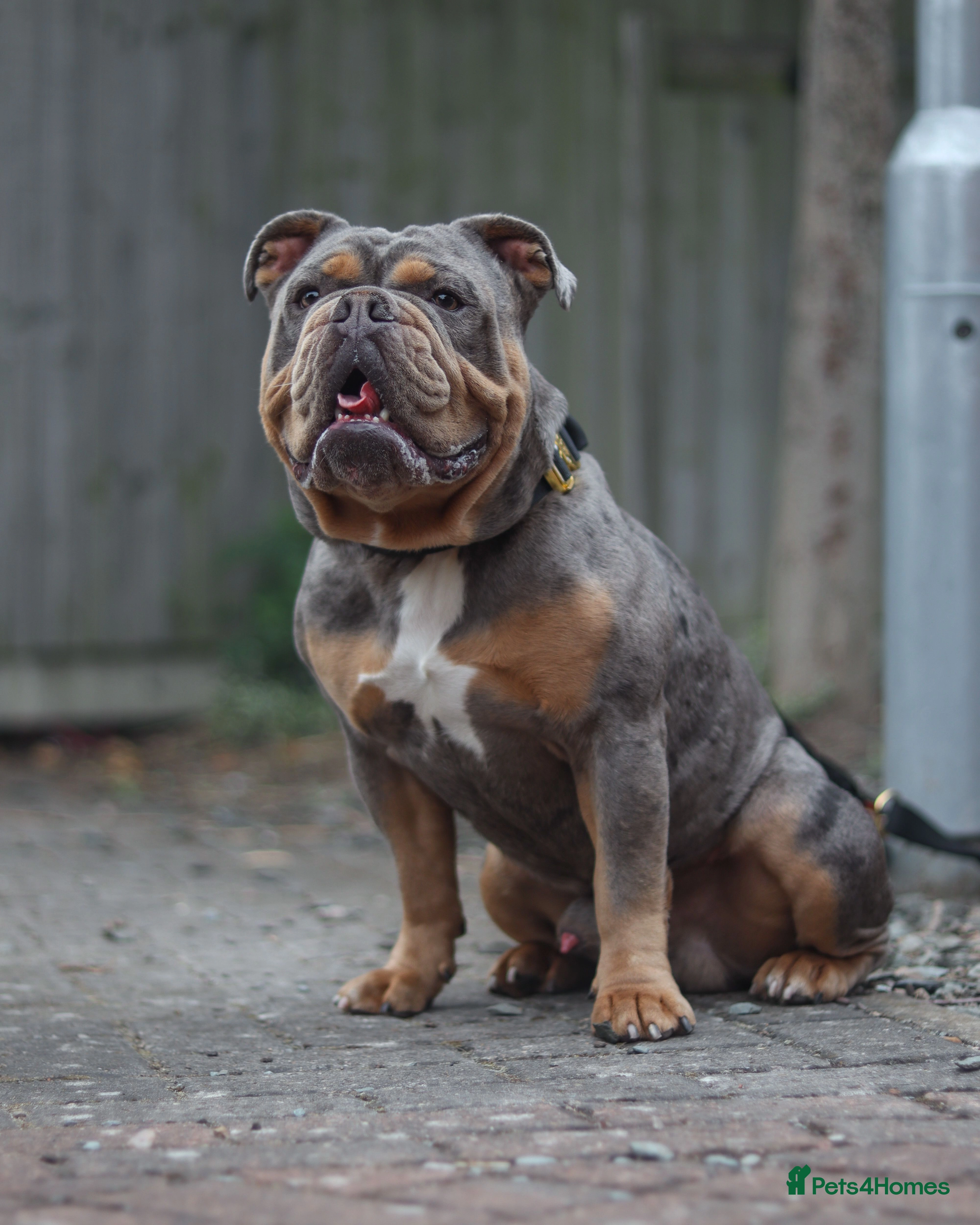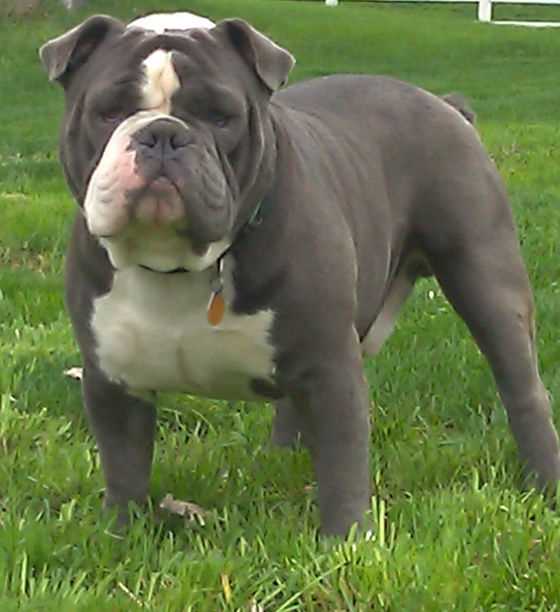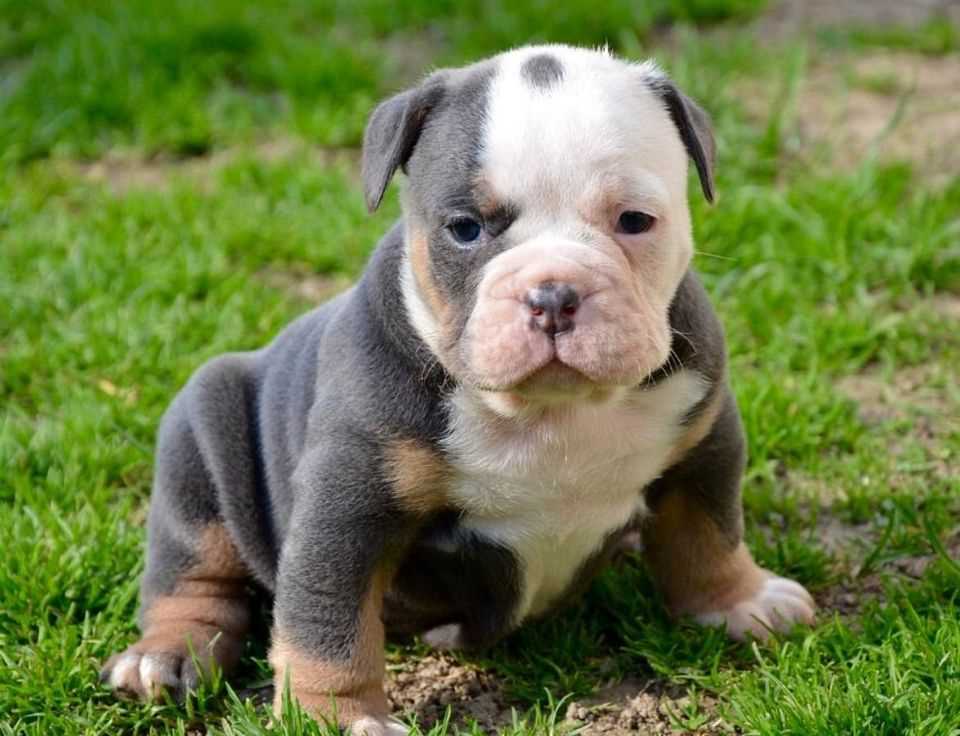
The Old English Bulldog Blue is a rare and unique breed of dog that has gained popularity in recent years. Known for their striking blue coat and muscular build, these dogs are a sight to behold. But there is more to the Old English Bulldog Blue than just their appearance.
This breed is known for their friendly and outgoing personality. They are loyal and affectionate towards their owners, making them excellent family pets. Despite their muscular build, they are gentle and patient with children, making them a great choice for families with young kids. They are also highly intelligent and eager to please, which makes them easy to train.
The Old English Bulldog Blue is a healthy and robust breed, with few genetic health issues. They have a life expectancy of around 10-12 years, which is relatively long for a dog of their size. However, they do require regular exercise and mental stimulation to keep them happy and healthy. Daily walks and playtime in a secure yard are essential for this breed.
If you are considering adding an Old English Bulldog Blue to your family, it is important to do your research and find a reputable breeder. This breed is still relatively rare, so finding a responsible breeder may take some time and effort. But the rewards of owning one of these beautiful and unique dogs are well worth it.
History
The Old English Bulldog Blue is a breed that has a fascinating history. It originated in England in the 18th century and was primarily used for bull-baiting, a popular sport at the time. The breed was developed by crossing the Old English Bulldog with various terrier breeds to enhance its agility and strength.
During the 19th century, bull-baiting was banned in England, which led to a decline in the popularity of the Old English Bulldog. However, a group of enthusiasts decided to preserve the breed by crossing it with other breeds, such as the Bull Terrier and the Staffordshire Bull Terrier. This resulted in the creation of the Old English Bulldog Blue.
The Old English Bulldog Blue is known for its distinctive blue coat, which is a result of a recessive gene. This gene gives the breed its unique appearance and sets it apart from other bulldog breeds.
Preservation Efforts

Due to the decline in popularity of the Old English Bulldog, the breed was on the verge of extinction. However, dedicated breeders and enthusiasts worked tirelessly to revive the breed and ensure its survival.
These preservation efforts involved careful breeding and selection to maintain the breed’s desired traits, such as its muscular build, strong jaw, and friendly temperament. Breeders also focused on eliminating any health issues that were common in the breed.
Today, the Old English Bulldog Blue is recognized as a distinct breed and is gaining popularity among dog enthusiasts. It is known for its loyalty, intelligence, and affectionate nature. The breed is also highly adaptable and can thrive in various environments, making it a popular choice for families and individuals alike.
Conclusion
The history of the Old English Bulldog Blue is a testament to the resilience and dedication of breeders and enthusiasts. Through their efforts, this unique breed has been preserved and is now thriving. With its distinctive appearance and friendly temperament, the Old English Bulldog Blue continues to capture the hearts of dog lovers around the world.
Appearance
The Old English Bulldog Blue is a medium-sized dog breed that has a strong and muscular build. They have a broad chest, thick neck, and a powerful jaw. Their head is large and square-shaped, with a wrinkled forehead and a short muzzle. The eyes of the Old English Bulldog Blue are round, set wide apart, and can be either brown or blue in color.
This breed has a short and dense coat that comes in various shades of blue, ranging from light gray to dark blue. Their coat is smooth and glossy, and they have loose and wrinkled skin, especially around their face and neck. The Old English Bulldog Blue has a distinctive appearance that is both athletic and intimidating.
Size
The Old English Bulldog Blue is a medium-sized breed, with males typically weighing between 50 to 70 pounds (22 to 32 kg) and standing around 17 to 20 inches (43 to 51 cm) tall at the shoulder. Females are slightly smaller, weighing between 40 to 60 pounds (18 to 27 kg) and standing around 16 to 19 inches (41 to 48 cm) tall.
Build
This breed has a sturdy and muscular build, with a deep chest and well-developed shoulders. They have a broad and powerful head, with a pronounced stop and a strong jaw. The neck of the Old English Bulldog Blue is thick and muscular, blending smoothly into their shoulders. Their body is compact and well-proportioned, with a straight back and a slightly arched loin. Their tail is set low and is usually carried low or curved.
The Old English Bulldog Blue has a distinctive appearance that sets them apart from other Bulldog breeds. They are known for their athletic and muscular build, which gives them a powerful and intimidating presence. Despite their strong and muscular appearance, they are agile and capable of quick movements.
Temperament
The Old English Bulldog Blue is known for its friendly and affectionate temperament. Despite its muscular appearance, this breed is gentle and loving, making it an excellent choice for families with children. They are known to be patient and tolerant, and they get along well with other dogs and pets.
These dogs are highly adaptable and can thrive in various living situations. They are equally happy in an apartment or a house with a yard, as long as they receive enough exercise and mental stimulation. However, they do not do well in extreme temperatures and should be kept indoors during hot summers and cold winters.
Protective and Loyal
The Old English Bulldog Blue is naturally protective of its family and home. They have a strong sense of loyalty and will do whatever it takes to keep their loved ones safe. While they are not typically aggressive, they will not hesitate to defend their territory if they feel threatened.
It is important to socialize these dogs from an early age to ensure they are well-behaved and friendly towards strangers. Early socialization will also help prevent any potential aggression or fear-based behaviors from developing.
Playful and Energetic

Despite their laid-back nature, Old English Bulldog Blues are still playful and energetic. They enjoy interactive playtime with their owners and thrive on mental stimulation. Puzzle toys and interactive games are great ways to keep them entertained and prevent boredom.
Regular exercise is essential for this breed to maintain a healthy weight and prevent obesity. Daily walks, play sessions, and mental exercises are all necessary to keep them physically and mentally fit.
Care
Taking care of an Old English Bulldog Blue requires attention to their physical and mental well-being. Here are some important aspects to consider:
Diet

Feeding your Old English Bulldog Blue a balanced diet is crucial for their overall health. Consult with a veterinarian to determine the best diet plan for your dog, taking into account their age, weight, and any specific dietary needs they may have. It is important to provide them with high-quality dog food that is appropriate for their breed and size.
Exercise
Regular exercise is essential for keeping an Old English Bulldog Blue healthy and happy. These dogs have a moderate energy level and require daily walks and playtime to burn off excess energy. Engaging in activities such as fetch or agility training can also help stimulate their minds and prevent boredom.
Grooming
The Old English Bulldog Blue has a short, dense coat that requires minimal grooming. Regular brushing with a soft bristle brush can help remove loose hair and keep their coat looking shiny. It is also important to clean their ears regularly and trim their nails as needed.
Healthcare
Regular veterinary check-ups are essential to ensure the health and well-being of your Old English Bulldog Blue. Vaccinations, parasite prevention, and dental care should be part of their routine healthcare. It is important to monitor their weight and watch for any signs of illness or discomfort.
Training and Socialization
Proper training and socialization are important for an Old English Bulldog Blue to become a well-behaved and balanced dog. Start training from a young age and use positive reinforcement techniques to encourage good behavior. Socialize your dog with other animals and people to help them become comfortable in different situations.
By providing proper care, nutrition, exercise, and training, you can ensure that your Old English Bulldog Blue lives a happy and healthy life.
Training
Training is an essential part of owning an Old English Bulldog Blue. These dogs are intelligent and eager to please, which makes them highly trainable. However, they can also be stubborn at times, so it’s important to use positive reinforcement techniques and be patient with them.
Start training your Old English Bulldog Blue from a young age to establish good habits and prevent any behavioral issues. Socialization is also crucial, as these dogs can be protective and wary of strangers if not properly exposed to different people, animals, and environments.
When training your Old English Bulldog Blue, focus on positive reinforcement methods such as rewards, praise, and treats. They respond well to motivation and are more likely to repeat desired behaviors when rewarded. Avoid using harsh punishments or physical force, as it can lead to fear or aggression in these sensitive dogs.
Basic obedience commands, such as sit, stay, come, and down, should be taught early on. Consistency and repetition are key to ensuring that your Old English Bulldog Blue understands and follows these commands in various situations. Use short training sessions and keep them engaging and fun to maintain your dog’s interest and attention.
Old English Bulldog Blues are also known for their athleticism and strength. Providing them with regular exercise and mental stimulation is essential for their overall well-being and to prevent boredom-related behaviors. Incorporate activities such as walks, playtime, and puzzle toys into their daily routine.
Consider enrolling your Old English Bulldog Blue in obedience classes or working with a professional dog trainer to enhance their training and socialization. These classes can provide structured learning environments and help you address any specific training challenges or concerns you may have.
Remember, training is an ongoing process throughout your dog’s life. Continue to reinforce good behaviors, address any new challenges that arise, and adapt your training techniques as needed. With patience, consistency, and positive reinforcement, you can have a well-trained and obedient Old English Bulldog Blue.
Health
The health of the Old English Bulldog Blue is of utmost importance. This breed is generally known for its robust and sturdy nature, but there are still some health concerns that potential owners should be aware of.
One common health issue that can affect the Old English Bulldog Blue is hip dysplasia. This is a condition where the hip joint does not develop properly, leading to pain and mobility issues. Regular exercise and maintaining a healthy weight can help reduce the risk of hip dysplasia.
Another health concern for this breed is brachycephalic syndrome. Due to their flat faces and short noses, Old English Bulldog Blues can have difficulty breathing, especially in hot weather or during intense exercise. It is important to provide them with a cool and well-ventilated environment and avoid strenuous activities in extreme temperatures.
Old English Bulldog Blues are also prone to skin allergies and infections. Regular grooming and proper hygiene practices can help prevent these issues. It is important to clean their wrinkles and folds regularly and keep their ears clean and dry to avoid infections.
Additionally, like many other large breeds, Old English Bulldog Blues can be prone to joint problems such as arthritis and elbow dysplasia. Providing them with a balanced diet, regular exercise, and appropriate supplements can help maintain their joint health.
Regular veterinary check-ups and vaccinations are essential for the overall health and well-being of the Old English Bulldog Blue. It is important to stay up to date with their vaccinations and ensure they receive necessary preventive treatments for parasites such as fleas and ticks.
Overall, with proper care and attention to their health needs, the Old English Bulldog Blue can lead a happy and healthy life. It is important for potential owners to be aware of these health concerns and be prepared to provide the necessary care and support for their beloved pet.

Tyler Newsom, a canine enthusiast, is passionate about bulldogs and their coat care. With years of experience and dedication, he shares his expertise to help bulldog owners maintain their beloved pets’ fur health and vitality through practical tips and advice.
